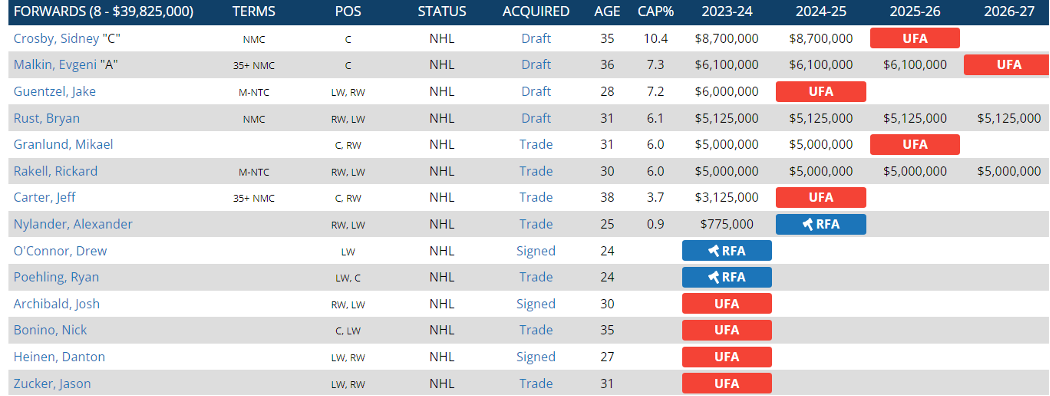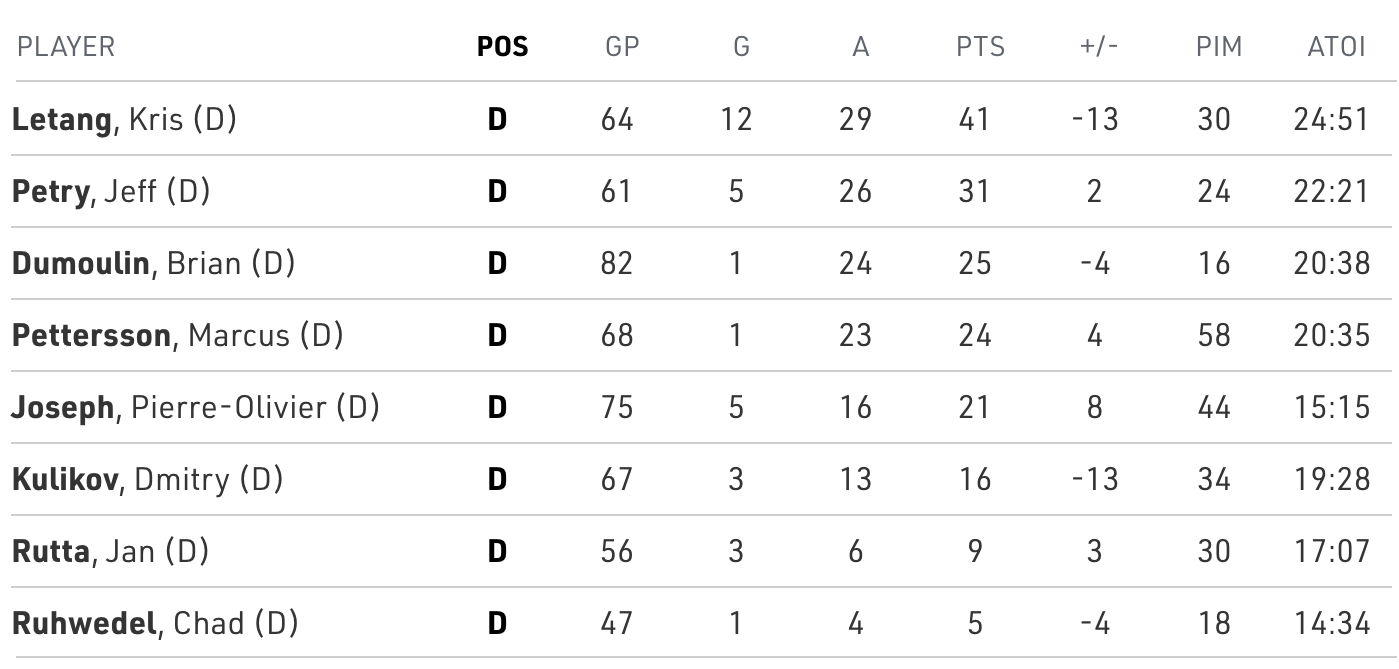The last couple of weeks have been interesting, to say the least, for the Toronto Maple Leafs, Pittsburgh Penguins and Kyle Dubas.
With Dubas officially joining the Penguins as president of hockey operations this week, let’s take a look at the state of the organization and what Dubas is inheriting in Pittsburgh.
AGING NHL ROSTER + CORE
When the puck drops to start the 2023-24 season, the Penguins will hit the ice with one of the oldest cores in the entire NHL. Sydney Crosby turns 36 this summer, Evgeni Malkin will be 37 and Kris Letang is 36.
The good news is Crosby and Malkin continue to produce offensively and play to their identity. They led the Pens in scoring this past season. Crosby had a terrific season overall.

Letang led the d-core offensively, averaged nearly 25 minutes of ice time per game, and was deployed in all situations. He was 10 points clear of the second-most productive Penguin defenceman, Jeff Petry.

The obvious question is: When will these three franchise cornerstones run out of gas?
Letang has suffered through some health scares, including another stroke this past season. Malkin has battled through knee injuries, but bounced back and played a full 82 games this year. Crosby has been mostly healthy and feels like the NHL version of Tom Brady. Would anyone be surprised to see him play until he’s 40 and continue to average, at least, a point per game?
The forward group the Penguins iced this past season was the third oldest in the entire NHL. Other aging members on the roster include Jeff Carter (37), Jeff Petry (35), Chad Ruhwedel (33), Jan Rutta (32), Bryan Rust (31), Mikael Granlund (31) and Casey DeSmith (31).
The team’s d-core was the oldest in the entire league.
NHL Forwards: The roster is obviously top heavy with Crosby and Malkin leading the way offensively.

Jake Guentzel is producing (36G – 37A) alongside Crosby and he’s entering the final year of his contract. If Pittsburgh isn’t able to extend Guentzel, on his terms, he will be a name to keep a close eye on when trade winds start blowing in the not-so-distant future.
The second layer of offence comes from Bryan Rust (20G – 26A) and Rickard Rakell (28G -32A). Both are signed through 2027-28.
Mikael Granlund’s contract is an outlier. I would be shocked if there is a market for his services elsewhere in the league. In my opinion, his scenario has ‘buyout candidate’ written all over it.
This is what buying out Granlund would look like for Pittsburgh:

Another terrible contract on the roster belongs to Jeff Carter, who has had a terrific career but one more year at $3.125M isn’t ideal. Making matters worse is the fact his deal is a 35+ contract – meaning buying him out wouldn’t save the team any cap dollars.
The roster falls off precipitately after that. Jason Zucker might be a target to re-sign as an unrestricted free agent, but the other UFAs don’t move the needle much.
Drew O’Connor and Ryan Poehling are restricted free agents. O’Connor is coming off a productive world championship, scoring three goals and five assists in 10 games while representing Team USA. His qualifying offer is set at $787K. Poehling hasn’t found much momentum in Pittsburgh. His numbers are pedestrian (7G – 7A) while averaging 12 minutes of ice time. But the Penguins don’t have many prospects knocking on the door for NHL jobs, so I expect Poehling to accept his qualifying offer of $787K, if the Pens extend it to him.
NHL Defenceman

Pittsburgh had only two defenceman under the age of 30 on their roster last season. Brian Dumoulin is the only one set to depart the organization as a UFA. This isn’t a group that can defend when games turn into “track meets” at the NHL level. It’s obvious the Penguins need to find a way to upgrade their defensive core to remain competitive next season.
Marcus Pettersson has turned into a solid two-way defenceman who averages over 20 minutes per game. All of his ice time comes at even strength or on the penalty kill. Pettersson plays hard minutes. He blocked 131 shots and finished with 133 hits last season.
P.O. Joseph is turning the corner at the NHL level and playing a much more responsible game overall. He’s still a work in progress, but the Penguins don’t have a ton of youth on their roster and he fits well under the salary cap and has time on his side to continue to evolve. Joseph is best described as a two-way defender who doesn’t bring a ton of physical edge or shot blocking to the dance. He’s an “area” defender who rarely sees time on the penalty kill but does have enough skill to take up a spot on the second power-play unit in Pittsburgh.
Jan Rutta is signed through 2024-25 with a cap hit of $2.75M per year. He’s a complimentary defenceman who can be paired with a more active partner. He leans “defensive defenceman” over offence. Rutta isn’t getting any faster. He’s also not intimidating physically, or a defender who blocks a ton of shots. He played through injury last season. Rutta underwent “core muscle” surgery in April and it’s going to take 8-10 weeks for the injury to heal. If healthy, he’s a bottom pairing defenceman at this stage of his career.
Petry, and the two years remaining on his contract, is a polarizing scenario for Pittsburgh. On one hand, his statistics weren’t as bad as people make them out to be. He recorded five goals and 26 assists while averaging over 22 minutes per game. He was deployed in all situations, also contributing 190 hits and 111 blocked shots.
The real concern is whether or not he can find a way to contribute more offensively at this stage of his career. Petry turns 36 this December. He suffered through some injuries this past season, dressing for only 61 games. He’s also lost a step gapping up defensively and tracking back into his zone to win races to pucks.
His contract is armed with the following pay schedule and clauses:

I project the Pens playing Petry on the second pairing alongside Joseph.
NHL Goaltenders
Casey DeSmith is under contract for one more year at $1.8M. He played the most games of his career last season (38) and his numbers fell off pretty dramatically from the previous year when he played (26) games. Pittsburgh needs him to be better than he was last year. The margins are slim between being a playoff team and playing golf in April. Most NHL teams require their back-up goalie to play between 25-32 games and give the team a chance to win when they do.

Tristan Jarry is a pending UFA. His previous contract carried an AAV of $3.5M. I’ve always been torn on whether or not Jarry is capable of carrying the load consistently. His year-over-year statistics speak to my concern. He has a history of flipping back and forth from below average goals against and save percentage to above average. Here’s a sample of the past four seasons:

One of the biggest off-season challenges the Penguins face is the reality they have very few NHL-ready prospects graduating out of their pipeline. Here are some notes on some of their most intriguing prospects:
Owen Pickering, Pittsburgh’s first-round pick (21st overall) in 2022, scored nine goals and 36 assists while playing in the WHL for Swift Current this past season. The 6-foot-4, 180-pound, left-shot defenceman is under contract but not ready for NHL duty. He projects as a “two-way D” who can compliment a more active d-partner. Pickering is at least two years away from full-time NHL duty.
The Penguins selected goaltender Joel Blomqvist in the second round (52nd overall) at the 2020 NHL Draft. He has a chance to be the goalie of the future in Pittsburgh but, like Pickering, it’s going to take time. The 6-foot-2,183-pound goalie plays mostly a butterfly/hybrid style. When he’s on his game he shows sound crease composure and limits any unnecessary movement. He’s athletic enough to move side-to-side quickly to make stops tracking the play laterally, or when pucks spill to his side off rebounds or bodies in front of his net. The transition to the North American ice surface and style of game will challenge him to start games on time mentally and adapt to the quick strike chances that are generated in the AHL and eventually the NHL. I envision two years of AHL seasoning before Blomqvist makes the jump to the NHL.
Forward Valtteri Puustinen is a restricted free agent who is due a qualifying offer in the coming weeks. He’s a small (5-foot-9, 180 pounds), darting, offensive talent who has produced well at the AHL level. Last season, he scored 24 goals and 35 assists for the Scranton-WilkesBarre Penguins. He’s a former seventh-round selection (203rd overall) from the 2019 draft. It’s getting to the point the NHL Pens will likely need to give him a long look to see if there is a fit on the roster. He won’t provide three-zone detail, but he might produce some depth scoring and roll over the boards on the second power-play unit. Players like this end up returning to their club teams in Europe if they feel they are running out of runway in North America. That’s why I suggest a long look at training camp in September.
Filip Hallander is an example of a player who has decided to return to Europe next season. He has signed a contract with Timra in the Swedish Hockey League (SHL).
Hallander was originally selected in the second round (58th overall) in 2018. Funny enough, he was traded to the Maple Leafs as part of the deal that sent Kasperi Kapanen to the Penguins (August 2020). Hallander was then traded back to Pittsburgh as part of the Jared McCann transaction (July 2021).
Pittsburgh will retain his rights next season. Hallander is a restricted free agent who scored 11 goals and 22 assists this past season in the AHL. I’m not sure he is anything but a depth NHL forward, but he’s still worth monitoring and could have value.
The Pens need to establish some grassroots momentum via the NHL Draft. They have been chasing Stanley Cups with their core for several years. The cost has come in the draft and develop department of the organization. The good news is they have a first-round selection in the upcoming draft, and an opportunity to add some quality prospects to their system.
Here’s a look at their draft grid for Nashville:

Pittsburgh’s pick is slotted at No. 14 in the first round. There is a possibility the team might have three or four players in mind around that slot. Some of those prospects might drop into the low 20s in the first round. Given the fact the team is without a second- or fourth-round pick, and the third they have is New Jersey’s (which is a late third-round slot), the Pens might be best to attempt to get creative and trade back in the first round to add more capital in subsequent rounds. They need all the prospects they can acquire.
Pittsburgh is a fascinating example of an organization that has won Stanley Cups with an elite core group of players. The fact they have tasted success leaves them wanting more in the near future. And that’s the key. Time is running out with the core group (Crosby, Malkin, Letang) and some players are getting close to free agency (Guentzel).
As weird as it sounds, the Penguins are as close to being contenders as they are falling out of being a playoff team. It’s a tight rope. The prospects need time to develop. The organization needs to be built up through the draft.
The great news is the team will have some cap flexibility this off-season to address some of the holes on their NHL roster. With over $20 million to spend this off-season, Dubas and his staff have a unique opportunity to take another run with their elite core, provided the dollars are spent responsibly on their back end and between the pipes.







COMMENTS
When submitting content, please abide by our submission guidelines, and avoid posting profanity, personal attacks or harassment. Should you violate our submissions guidelines, we reserve the right to remove your comments and block your account. Sportsnet reserves the right to close a story’s comment section at any time.